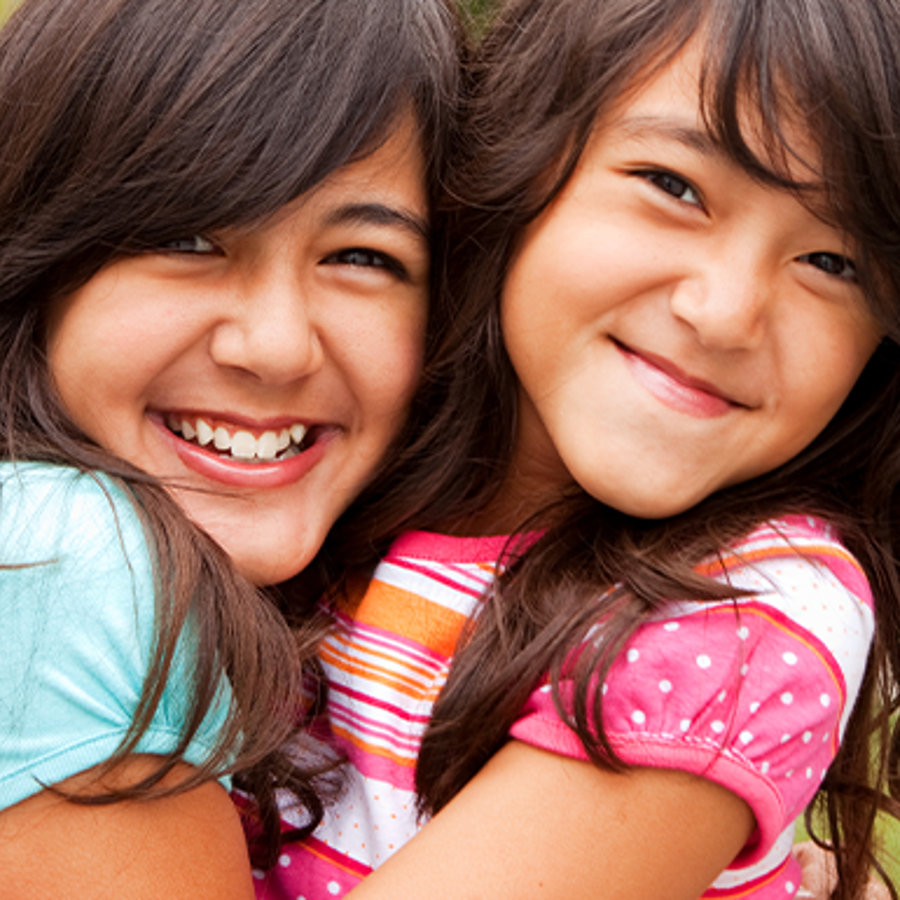
If two kids have the same dad, and their moms are sisters, how are they related?
September 9, 2014

- Related Topics:
- Relatedness,
- Complicated family trees,
- Recombination
A science-minded software engineer from Idaho asks:
"If two kids have same dad but their moms are sisters and the sisters are from same mom and dad, are the kids full siblings or half? And how can we explain to them that they’re not cousins but siblings?"
The two kids would be somewhere in between full and half siblings. You could call them “three-quarters” siblings.
Full siblings share on average ½ of their DNA, while half siblings share ¼. Two kids with the same dad but moms that are sisters would share ⅜ of their DNA.
The two kids are definitely closer to being siblings than cousins at the genetic level. Cousins only share on average ⅛ of their DNA.
As to how the kids see themselves, genetics should probably not be the only factor. After all, adopted and biological kids in the same family will generally see themselves as siblings even though there is no genetic connection. The words brother and sister are often used to indicate a certain kind of close relationship, not the exact level of genetic identity between people.
For the rest of this answer, I’ll explain where the ½, ¼, ⅜, and ⅛ figures came from. As you'll see, it isn’t as straightforward as you might think.
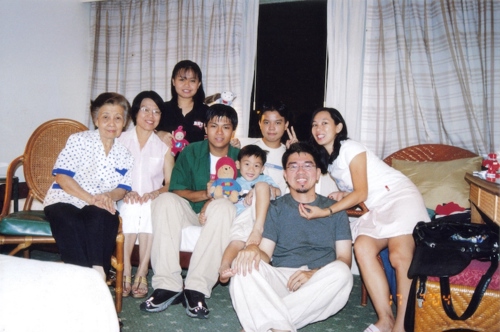
Inheritance of DNA
Human DNA is split into 23 long pieces called chromosomes. Every person has two copies of every chromosome.* When parents have a child, the child gets one copy of each pair from mom and one from dad. In the end they have 23 pairs again.
(* Except for men who have an X and a Y as one of their pairs.)
However, the copy of a chromosome that a child gets from a parent isn’t exactly the same as either copy from the parent. In the process of passing down one set of chromosomes, pieces of each copy of a chromosome in a pair get mixed together to form a chromosome that is a mixture of the original two. This mixing is called recombination and looks something like this:
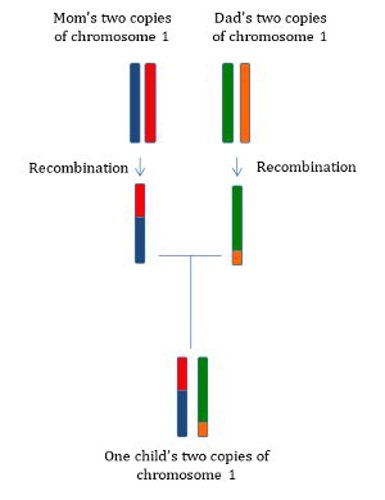
We are just looking at one pair of chromosomes in this diagram. Mom has a red and a blue chromosome and dad has a green and an orange chromosome.
As you can see, the child didn’t get either a red or a blue from mom. Instead, the child got a brand new chromosome made up of large chunks of both.
You can also see that recombination happens at only a couple of spots on each chromosome. This means that long stretches of a child’s DNA will have come from a particular chromosome from either mom or dad.
Here is it might look like for a second child:
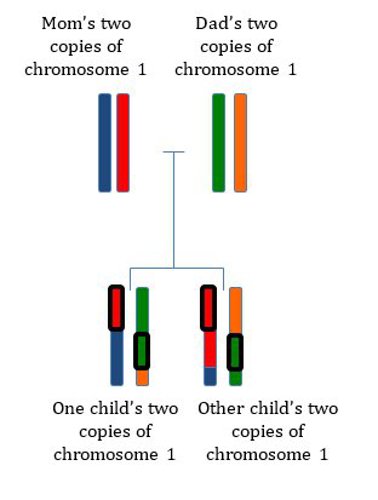
You can see in the image that each child did not inherit the same DNA from their parents. Recombination happens at different spots on the DNA. Where it happens ends up being pretty random (although there are “hotspots” where it is more common).
From the image you can also see that two different children from the same parents will have different DNA because the DNA from the parents will get mixed differently. The regions that are identical are surrounded by the thick black boxes. On average, siblings will share about 50% of their DNA, although it will vary slightly. (For more on this click here.)
Similarity Between First cousins, Half Siblings, and Three-Quarters Siblings
First cousins share a lot less DNA than siblings. Consider the case of two moms that are sisters and each have a child with different, unrelated men. These kids will be first cousins. Here’s what our diagram for chromosome 1 would look like:
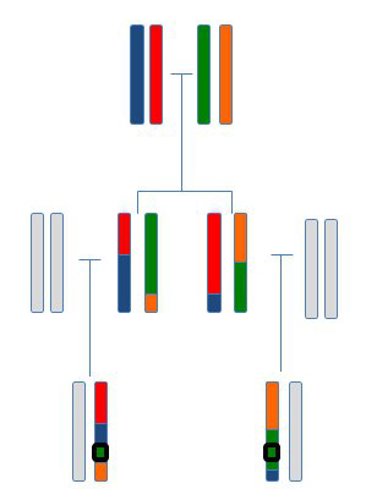
We are sticking with the two siblings from our previous image, but adding the next generation. Each of these sisters married two unrelated men.
The chromosomes passed on from the dads will be pretty different. I have colored these chromosomes gray because we will ignore them. Focus only on the brightly colored chromosomes as the chromosomes from the fathers will pretty much not share any related DNA.
As you can see, the cousin on the right happened to get no red DNA. The two cousins share none of this DNA.
You can see that they each got some orange and blue DNA but none of this overlapped. For example, one cousin got a bit of orange on the bottom of one chromosome and the other got a big chunk of orange at the top. These are both orange but not shared between the two.
They do share a bit of the green though. These bits are again highlighted by the thick black boxes. When this sort of result is spread over the other 22 shared chromosomes, these first cousins will share on average about 1/8 of their DNA.
Another way to think about it is that after another generation or round of mixing, the two cousins’ chromosomes from their moms will be on average 1/4 the same. Since the chromosomes from their moms only make up half of their DNA, in total they will only be 1/8 similar.
Now let’s consider half siblings with the same dad, but different, un-related moms:
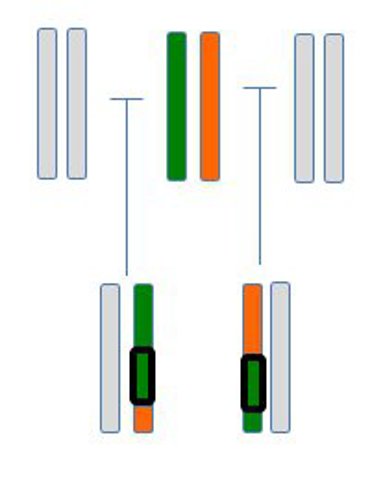
In this case, the common dad has a green and an orange chromosome. I have grayed out mom’s chromosomes because again, they don’t matter here.
For half siblings with different moms but the same dad, the kids’ chromosomes from their moms will be very different. For the chromosomes from the dad, the DNA will be ½ the same like for full siblings. In total the half siblings will be ¼ the same at the level of DNA (half of the half DNA from the common parent.
OK, now we are ready to tackle your question. For this we need to fill in the gray parts of the half sibling diagram. Here is what that might look like:
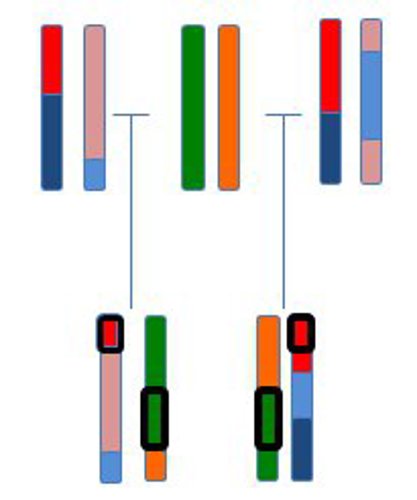
OK so the shared dad is still green and orange with the same results for the kids. Moms’ DNA is a bit more complicated.
The moms are sisters so they share around half their DNA. This is shown in the common blue and red areas on the first chromosome and the common pink and light blue areas on the second. In the kids, only a small bit of the red is shared in the DNA coming from the mom (circled in black). The shared DNA will be around ¼ on average (the shared dark blue DNA in this case).
So the chromosomes the kids get from the dad’s side will be ½ alike (like for full siblings). The chromosomes the kids get from the mom’s side will be ¼ the same (like for cousins). Overall, the kids will be 3/8 the same.

Author: Alicia Schep
When this answer was published in 2014, Alicia was a Ph.D. candidate in the Department of Genetics, studying the role of nucleosome positioning in gene regulation in Will Greenleaf’s laboratory. She wrote this answer while participating in the Stanford at The Tech program.
 Skip Navigation
Skip Navigation
